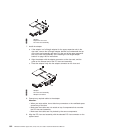v The specifications of a DDR3 DIMM are on a label on the DIMM, in the following
format.
ggg eRxff-PC3-wwwwwm-aa-bb-cc
where:
ggg is the total capacity of the DIMM (for example, 1GB, 2GB, or 4GB)
e is the number of ranks
1 = single-rank
2 = dual-rank
4 = quad-rank
ff is the device organization (bit width)
4 = x4 organization (4 DQ lines per SDRAM)
8 = x8 organization
16 = x16 organization
wwwww is the DIMM bandwidth, in MBps
6400 = 6.40 GBps (PC3-800 SDRAMs, 8-byte primary data bus)
8500 = 8.53 GBps (PC3-1066 SDRAMs, 8-byte primary data bus)
10600 = 10.66 GBps (PC3-1333 SDRAMs, 8-byte primary data bus)
12800 = 12.80 GBps PC3-1600 SDRAMs, 8-byte primary data bus)
m is the DIMM type
E = Unbuffered DIMM (UDIMM) with ECC (x72-bit module data bus)
R = Registered DIMM (RDIMM)
U = Unbuffered DIMM with no ECC (x64-bit primary data bus)
aa is the CAS latency, in clocks at maximum operating frequency
bb is the JEDEC SPD Revision Encoding and Additions level
cc is the reference design file for the design of the DIMM
d is the revision number of the reference design of the DIMM
v The following rules apply to single-rank and dual-rank DDR3 DIMM speed as it
relates to the number of DIMMs in a channel:
– When you install 1 DIMM per channel, the memory runs at 1333 MHz
– When you install 2 DIMMs per channel, the memory runs at 1066 MHz
– When you install 3 DIMMs per channel, the memory runs at 800 MHz
– All channels in a server run at the fastest common frequency.
– Mixing registered and unbuffered DIMMs is not supported.
v The DIMM options that are available for the server are 1 GB, 2 GB, 4 GB, and 8
GB (when available). The server supports a minimum of 1 GB and a maximum of
128 GB of system memory.
For 32-bit operating systems only: Some memory is reserved for various
system resources and is unavailable to the operating system. The amount of
memory that is reserved for system resources depends on the operating system,
the configuration of the server, and the configured PCI devices.
v A minimum of one DIMM must be installed for each microprocessor. For
example, you must install a minimum of two DIMMs if the server has two
microprocessors. However, to improve system performance, install a minimum of
three DIMMs for each microprocessor.
v The maximum operating speed of the server is determined by the slowest DIMM
in the server.
Chapter 6. Removing and installing FRUs 189


















